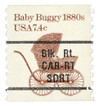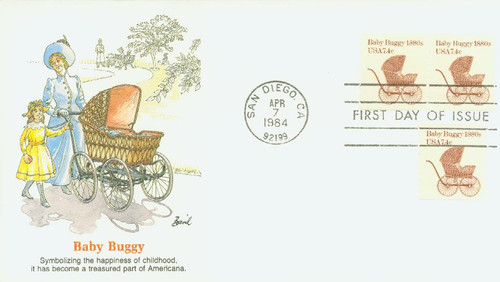
# 1902a - 1984 7.4c Baby Buggy, precancel
1984 7.4¢ Baby Buggy Precancel
Transportation Series
City: San Diego, CA
Start Of The Transportation Series

On May 18, 1981, the USPS issued the first stamp in the Transportation Series, U.S. #1907, picturing the Surrey, a doorless four-wheeled carriage.
Prior to the stamp’s issue, the USPS issued a brief announcement for the stamp saying it would be printed in black ink, with few other details. However, the actual stamp was printed in brown ink.
The stamp was issued quietly on May 18, 1981, without the fanfare many issues received. It also broke an 80-year-old custom. For the first time in U.S. history, a coil stamp featured its own unique design rather than simply copying that of the current definitive stamp. Over 50 more coil stamps would be issued over the course of the next 15 years, each picturing a different mode of transportation. All of these were types of transportation used since American independence.
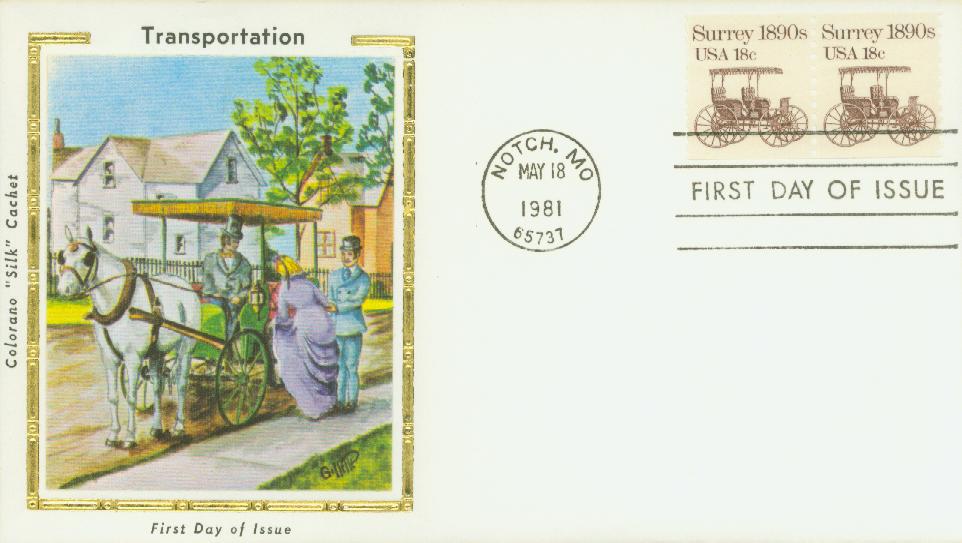
The various denominations provided face values to exactly match the rates for several categories of Third Class mail (bulk rate and quantity-discounted mail). As the rates changed, new stamps with new values were added. Never before had a stamp series included so many fractional cent values.
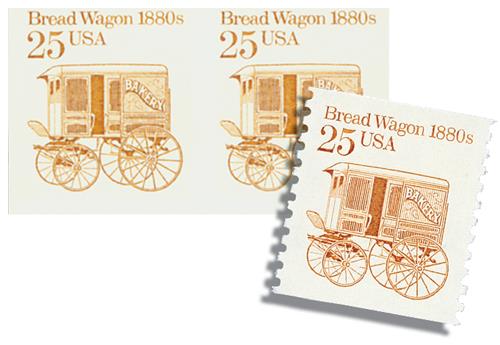
The Bureau of Engraving and Printing printed most of the stamps in the Transportation Series, although private contractors printed a few. All but a few of the later stamps were produced by engraved intaglio. Differences in precancels, tagging, paper and gum provide a large number of varieties.
One aspect of the Transportation stamps that is particularly interesting is the use of tiny plate numbers at the bottom of some stamps. These Plate Number Coils (PNCs) were printed at intervals of 24, 48, or 52 stamps, varying by which press was used.
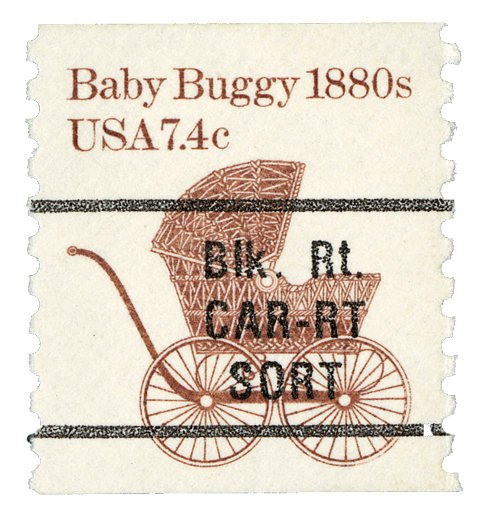
Because the Transportation stamps were most frequently used on bulk mailings, many of the stamps were issued with precancels, to save time on going through canceling equipment. These precancels were usually a pair of black lines with a service inscription between them, such as “Nonprofit Org.” Other times the service inscription was part of the design and the precancel was simply the two black bars. For several years, these precanceled stamps were only available to bulk mailers, who had to have special permits to use them. They weren’t made available to collectors until 1988.
Scott Catalog separates the Transportation stamps into four groups. The stamps in the first group (#1897-1908) generally have the denomination in small type with a “c” next to it. These stamps were printed on the Cottrell rotary press, which joined together two plates to make a sleeve. The gaps between these plates created depressions where ink would collect and create joint lines on the stamps. Later issues were printed on a different press and didn’t have these joint lines.
1984 7.4¢ Baby Buggy Precancel
Transportation Series
City: San Diego, CA
Start Of The Transportation Series

On May 18, 1981, the USPS issued the first stamp in the Transportation Series, U.S. #1907, picturing the Surrey, a doorless four-wheeled carriage.
Prior to the stamp’s issue, the USPS issued a brief announcement for the stamp saying it would be printed in black ink, with few other details. However, the actual stamp was printed in brown ink.
The stamp was issued quietly on May 18, 1981, without the fanfare many issues received. It also broke an 80-year-old custom. For the first time in U.S. history, a coil stamp featured its own unique design rather than simply copying that of the current definitive stamp. Over 50 more coil stamps would be issued over the course of the next 15 years, each picturing a different mode of transportation. All of these were types of transportation used since American independence.

The various denominations provided face values to exactly match the rates for several categories of Third Class mail (bulk rate and quantity-discounted mail). As the rates changed, new stamps with new values were added. Never before had a stamp series included so many fractional cent values.

The Bureau of Engraving and Printing printed most of the stamps in the Transportation Series, although private contractors printed a few. All but a few of the later stamps were produced by engraved intaglio. Differences in precancels, tagging, paper and gum provide a large number of varieties.
One aspect of the Transportation stamps that is particularly interesting is the use of tiny plate numbers at the bottom of some stamps. These Plate Number Coils (PNCs) were printed at intervals of 24, 48, or 52 stamps, varying by which press was used.

Because the Transportation stamps were most frequently used on bulk mailings, many of the stamps were issued with precancels, to save time on going through canceling equipment. These precancels were usually a pair of black lines with a service inscription between them, such as “Nonprofit Org.” Other times the service inscription was part of the design and the precancel was simply the two black bars. For several years, these precanceled stamps were only available to bulk mailers, who had to have special permits to use them. They weren’t made available to collectors until 1988.
Scott Catalog separates the Transportation stamps into four groups. The stamps in the first group (#1897-1908) generally have the denomination in small type with a “c” next to it. These stamps were printed on the Cottrell rotary press, which joined together two plates to make a sleeve. The gaps between these plates created depressions where ink would collect and create joint lines on the stamps. Later issues were printed on a different press and didn’t have these joint lines.



